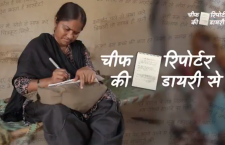Yet another animal shelter that’s not functional or practical, launched amidst fanfare in rural Bundelkhand.
In a bid to protect gau mata, the Uttar Pradesh Chief Minister Yogi Adityanath announced late last year that his government would set up gaushalas (cow shelters) in each of the 75 districts across the state. This move came as a result of the widespread nuisance caused by stray cows in the state, which was also one of the main focus points of the BJP’s election campaign in U.P. The situation reaches catastrophic proportions in the dry Bundelkhand area – an area facing extreme poverty and starved of development – due to the practice of “anna pratha” tat is typical to the area. Anna pratha is a ritual of sorts, referring to the act of farmers and others abandoning their cows when they stop producing milk, either because they are unable to grow enough to feed them or at the beginning of the summer season when there is a scarcity of water. These abandoned cows then run amuck, damaging the crops and fields that come in their way. Many are of the opinion that the situation has worsened ever since the cow’s elevated status was further strengthened in the BJP-led regime – part of which is linked to the fact of buffaloes’ utility value, which were usually kept safe until they were slaughtered for beef. But certain developments on that front have led to the buffaloes being abandoned too, in effect increasing the havoc inherent to the anna pratha.
As per the locals, there are more than 50,000 stray cows in the Bundelkhand region alone. Most of the farmers in Bundelkhand hence have been eating, sleeping and practically living on their fields guarding their crop 24×7. They spend their time ranting amongst each other about C.M.’s announcements, such as the recent one that declared anyone found being cruel to cows (leave aside killing them) would be put behind bars – these only add to their woes, they insist. Impoverished Bundeli farmers have even committed suicide due to the deep debt they find themselves in after losing all their crop to the mayhem of stray cows.
In a scenario such as this one, the hullabaloo that has arisen over the last month around the establishment of a cow shelter in Chitrakoot district’s Mau block, is quite understandable. Finally, stray cattle can be restricted and taken care of by the government, leaving the farmers’ fields un-trampled on.
The move was hence welcomed by the locals fed up of dealing with the stray cow menace. Inaugurated with great pomp and show on September 19, the event of the opening featured the local MLA from Mau-Manikpur, R.K. Patel, in visible attendance. Patel threw some light on the details of the project, “The state government has ordered for these gaushalas to be built in almost each block of every district so as to provide a home to stray cows and provide for their proper rearing. Each district is being allocated a particular sum of money – our district has been given around 1.5 crore rupees, for instance. Every shelter is going to be equipped with sheds, drinking water facilities, and a space for storing hay. We are spending 30-32 lakh rupees in setting up this particular shelter itself.”
But the initial excitement died down soon enough when the locals came to realise one huge, gaping flaw in the plan – the gaushala had no boundary walls! What’s more, the villagers soon discovered that the boundary wall was never a part of the budget at all. One of the locals, Ramesh Mishra, said, “Apparently, they are not making the boundary because it was never accounted for in the budget allocation. But it makes no sense without it. The cows will still be wreaking havoc everywhere.” While the farmers have been left to their own devices to deal with these cruel ground realities, the state government, it is alleged, has been making grand plans of turning cow urine and cow dung into flourishing industries – plans into which the gaushalas feature prominently.
The villagers’ disgruntlement has forced the local administration to take cognizance of the issue, even if momentarily. “We are now realising the technical problem of having an animal shelter with no boundary wall,” said Patel, with no hint of irony in his demeanour or tone, “All the facilities we plan on providing will be in vain if all the animals run away. Therefore, we have ordered for the work on the facilities to be ceased till a proper boundary is made. We have petitioned the DM to get a boundary wall constructed at the earliest.”
Meanwhile, Deepak, a Mau local, voices another concern that not many seem to have realised in the din around the boundary wall – the size and capacity of the animal shelter. “Our own village has so many stray animals – at least 400-500 of them. And the stray cows from four to five neighbouring villages are also expected to be rounded up and kept in this shelter. But it can only house maximum 700 animals at a time”, he says, asking us, “How will all the animals even fit?”
Evidently, this has not been part of the plan either. The MLA and MP from Mau have scheduled appointments to meet with the District Magistrate, primarily to discuss the issue of the boundary wall in the following week – a story we will follow-up.
Meanwhile, the farmers of Mau will be spending lots more sleepless nights, alert on sentry duty in their fields. The most desperate amongst them will probably be planning hara kiri.
This Khabar Lahariya article first appeared on The Wire.

